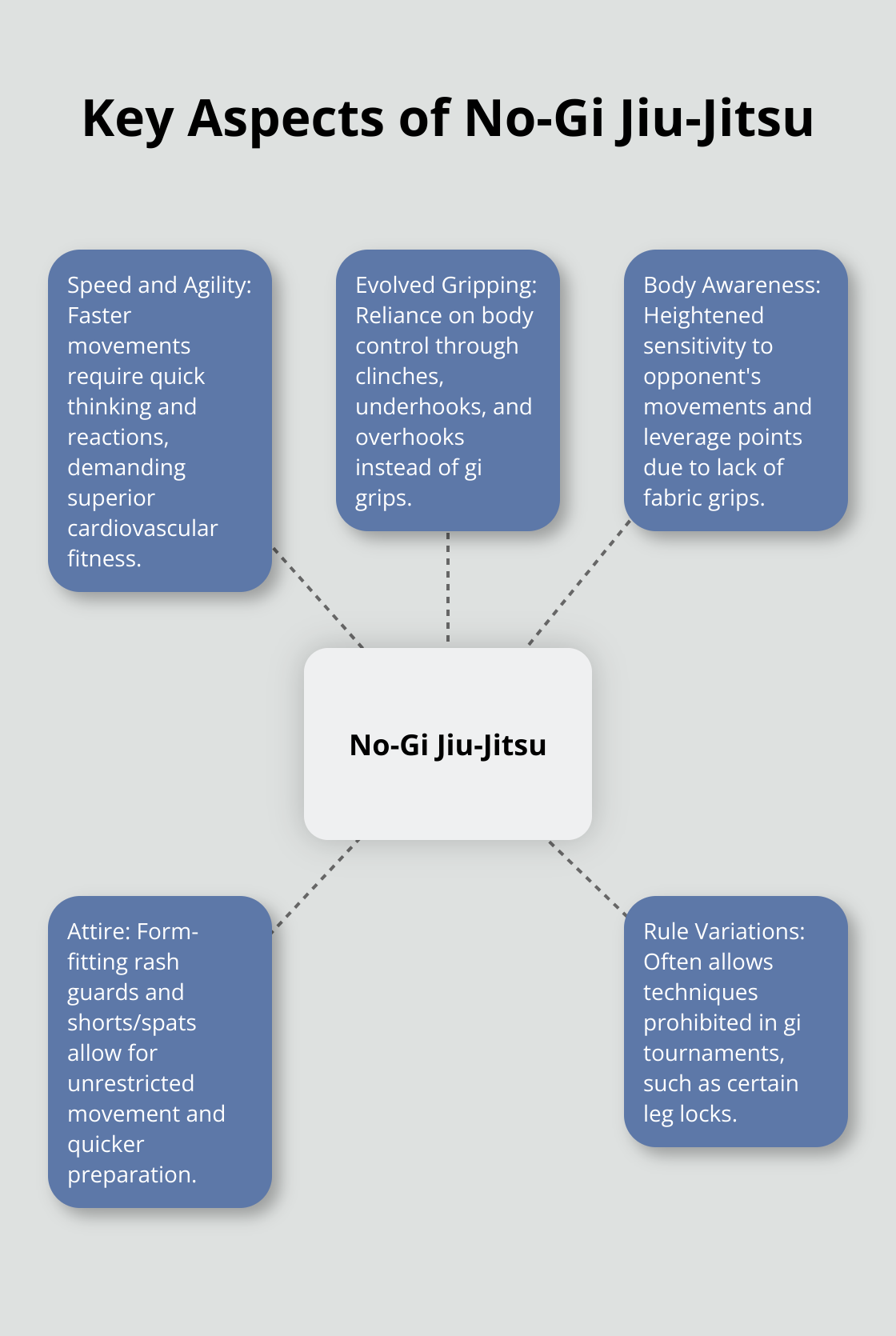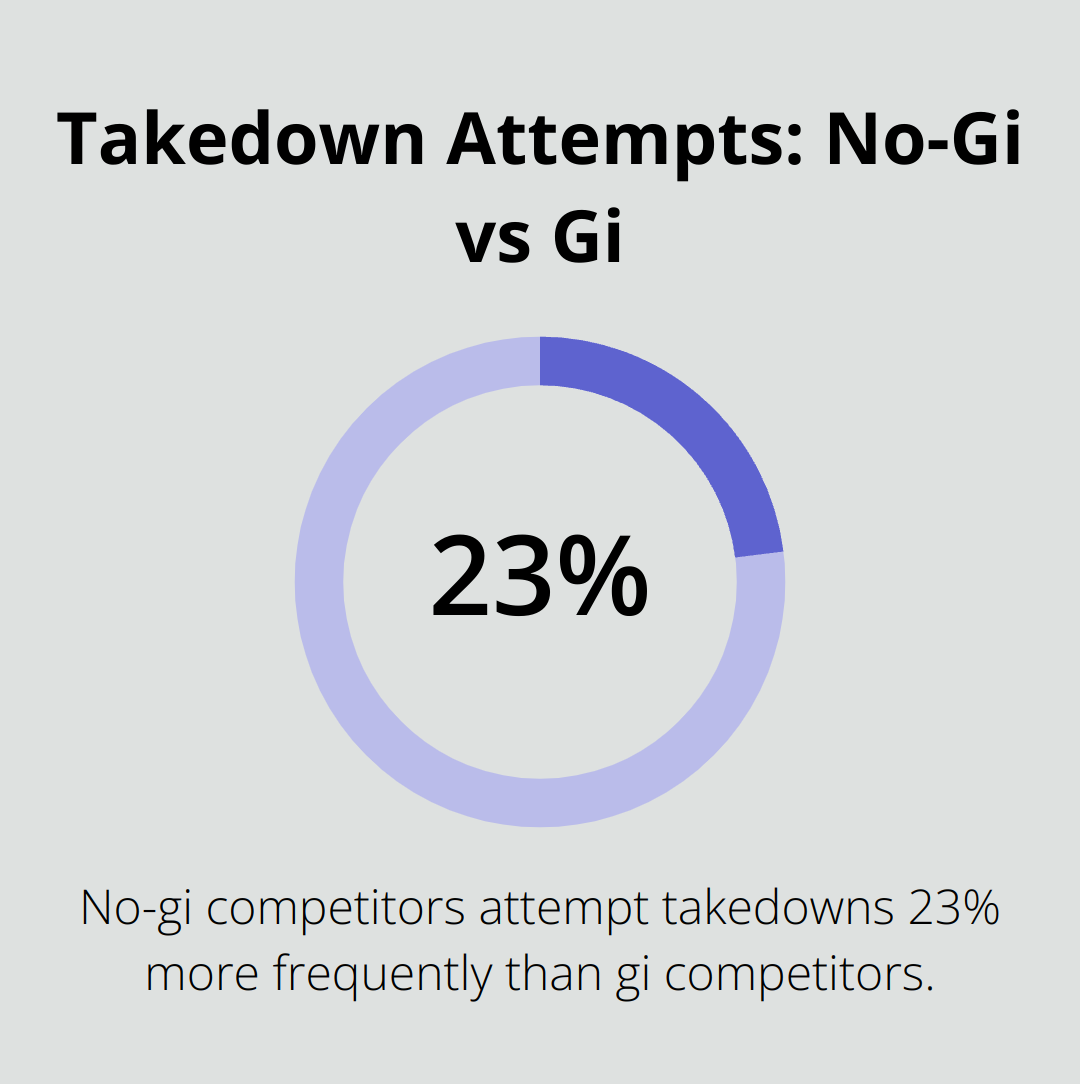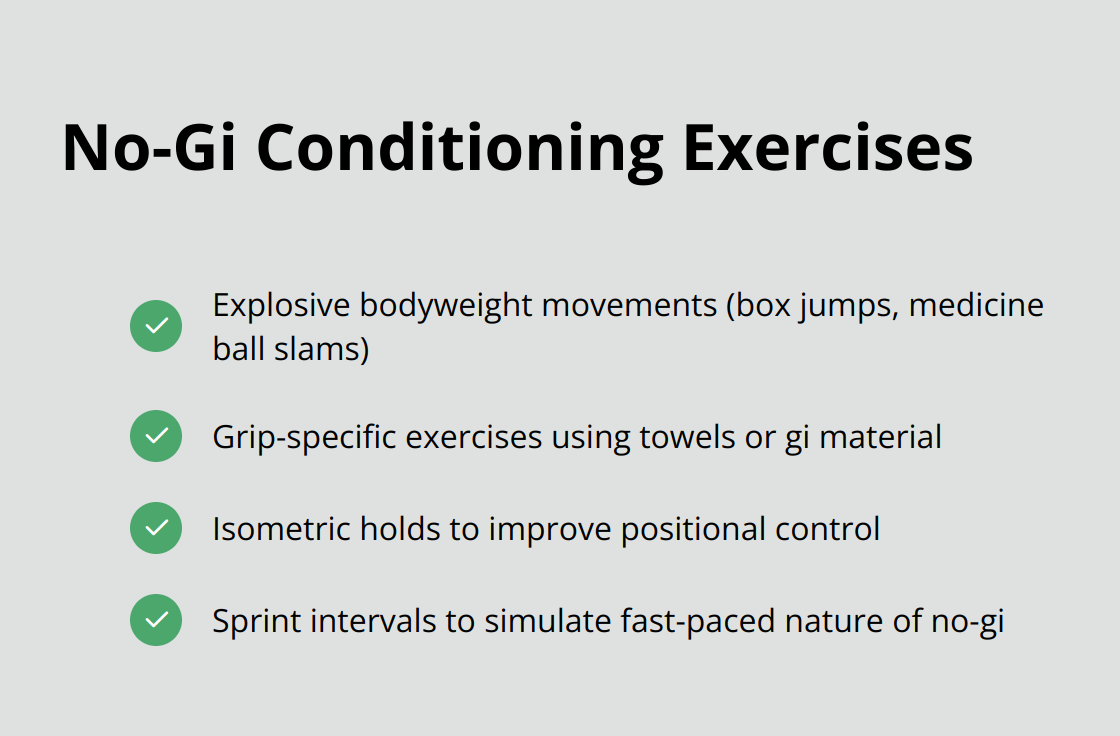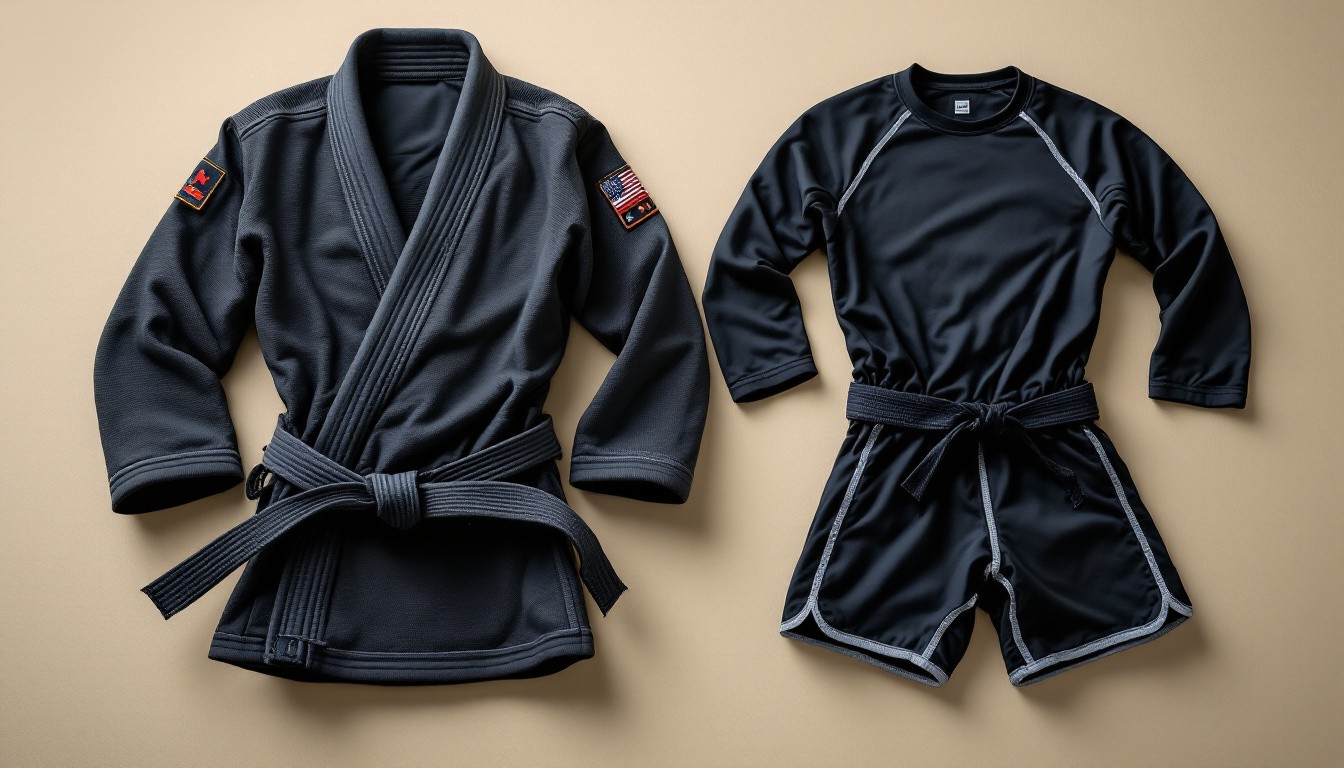At Jiu jitsu, we often get asked about the differences between gi and no-gi jiu-jitsu.
No-gi jiu-jitsu strips away the traditional kimono, creating a faster-paced and more dynamic grappling experience. This style requires unique techniques and training methods to excel.
In this post, we’ll explore the key distinctions between gi and no-gi, essential techniques, and effective training strategies for no-gi success.
What Sets No-Gi Apart
No-gi jiu-jitsu offers a distinct and thrilling variation of the traditional martial art. The absence of the kimono fundamentally changes the game, creating a faster and more explosive grappling experience.
Speed and Agility Take Center Stage
Without the friction of the gi, movements become lightning-fast. Practitioners find themselves in a constant state of motion, which requires quick thinking and even quicker reactions. This increased pace demands superior cardiovascular fitness and agility. High-intensity drills help build the stamina needed for this dynamic style.
Gripping Techniques Evolve
In gi jiu-jitsu, grips on the collar, sleeves, and pants play a crucial role. No-gi eliminates these options, forcing practitioners to rely on body control. Clinches, underhooks, and overhooks become the primary means of control. Specialized drills and sparring sessions help students master these techniques.
Body Awareness Intensifies
Without fabric to grab, no-gi jiu-jitsu emphasizes a deeper understanding of body mechanics and weight distribution. Practitioners must become hyper-aware of their opponent’s movements and leverage points. This heightened sensitivity often translates to improved overall grappling skills (even when returning to gi training).
Attire Differences
No-gi practitioners typically wear form-fitting rash guards and shorts or spats (tight-fitting pants). This attire allows for unrestricted movement and reduces the risk of fingers getting caught in loose fabric. The lack of a gi also means less laundry and quicker preparation time before training sessions.
Rule Variations
Many no-gi competitions allow techniques that are often prohibited in gi tournaments (such as certain leg locks). This opens up a wider range of submission options and strategic approaches. Competitors must adapt their game plans accordingly and be prepared for a broader spectrum of attacks.
As we transition to discussing essential no-gi techniques and strategies, it’s important to note that mastering these unique aspects of no-gi jiu-jitsu can significantly enhance your overall grappling skills.

Mastering No-Gi Techniques
No-gi jiu-jitsu requires a specific set of skills and strategies. Let’s explore key techniques that will elevate your no-gi game and give you an edge on the mat.
Clinch and Underhook Dominance
In no-gi, body control is paramount. Focus on developing a strong clinch game. Practice smooth transitions between over-under, double-under, and head-and-arm clinches. Regular drilling of these positions builds muscle memory.
Underhooks provide excellent control and set up numerous takedowns and submissions. Work on your underhook entries from various positions (standing and on the ground). The Brazilian Journal of Kinanthropometry and Human Performance found that underhook control significantly impacts successful takedowns in no-gi competitions.
Leg Lock Mastery
Leg locks form a cornerstone of modern no-gi jiu-jitsu. Start with the basics like straight ankle locks and kneebars. Progress to more advanced techniques like heel hooks and toe holds. Always prioritize safety and proper technique when practicing these submissions.
Leg entanglements create opportunities for submissions and sweeps while limiting your opponent’s mobility. Spend time drilling entries into the 411, saddle, and outside ashi garami positions.
Takedown Refinement
Without gi grips, your takedown game must adapt. Focus on wrestling-style takedowns like double legs, single legs, and ankle picks. Incorporate chain wrestling concepts to improve your success rate. A 2019 study in the Journal of Human Kinetics revealed that successful no-gi competitors attempted takedowns 23% more frequently than their gi counterparts.

Don’t neglect your defensive skills. Practice sprawls, underhook defenses, and hip positioning to thwart your opponent’s takedown attempts. A strong defensive game is just as valuable as offensive prowess.
Submission Transitions
In the fast-paced world of no-gi, the ability to chain submissions becomes even more critical. Practice flowing between different submission attempts (armbars to triangles, kimuras to arm triangles). This fluidity keeps your opponent guessing and increases your chances of securing a finish.
Positional Control
Without the friction of the gi, maintaining dominant positions requires different techniques. Focus on pressure-based control, using your body weight and leverage to pin your opponent. Drill transitions between positions to stay one step ahead in the scramble.
Now that we’ve covered essential no-gi techniques, let’s explore effective training methods to incorporate these skills into your routine.
How to Train for No-Gi Success
High-Intensity Circuit Training
We incorporate high-intensity circuit training into our classes to build a solid foundation of strength and conditioning. This approach ensures that your technique can shine through from the first match to the last.
Specialized Drilling Sessions
We allocate time to drill specific no-gi techniques. For example, a 20-minute session might focus solely on arm drag entries to takedowns. This repetitive practice improves execution speed and muscle memory.
Our coaches emphasize drilling both with and without rash guards. This variation helps students adapt to different levels of grip and friction they might encounter in competition.
Purposeful Live Rolling
During sparring sessions, we encourage students to set specific goals. One round might focus on maintaining top control without using gi grips. Another round could emphasize escaping from bottom positions using explosive movements.
This targeted approach to live rolling develops the problem-solving skills necessary in no-gi grappling.
Cross-Training Opportunities
Souza Grappling Co. offers cross-training options to enhance no-gi performance. Our Muay Thai classes improve striking defense and clinch work. Yoga sessions increase flexibility and body awareness (both vital for no-gi success).
We also invite guest instructors from wrestling and sambo backgrounds. Their unique perspectives provide valuable insights into takedowns and control techniques (specifically suited for no-gi grappling).
Conditioning for No-Gi Demands
No-gi grappling requires a specific type of conditioning. We implement exercises that mimic the demands of a no-gi match. These include:
- Explosive bodyweight movements (like box jumps and medicine ball slams)
- Grip-specific exercises (using towels or gi material)
- Isometric holds to improve positional control
- Sprint intervals to simulate the fast-paced nature of no-gi

These training methods help students develop a well-rounded skill set tailored for no-gi success. Our approach will help you thrive in the fast-paced world of no-gi jiu-jitsu, whether you’re a beginner or an experienced grappler.
Final Thoughts
No-gi Jiu-Jitsu offers a unique challenge that differs from its gi counterpart. The absence of the kimono creates a faster-paced, more dynamic grappling experience that demands quick thinking and explosive movements. Practitioners must rely on body control techniques, emphasizing clinches, underhooks, and overhooks instead of fabric grips.
Adapting your training methods is essential for success in no-gi Jiu-Jitsu. High-intensity circuit training builds the necessary strength and conditioning to maintain technique throughout grueling matches. Specialized drilling sessions that focus on no-gi specific techniques, such as leg locks and wrestling-style takedowns, develop a well-rounded skill set.
We encourage our students to embrace both gi and no-gi Jiu-Jitsu at Souza Grappling Co.. Our training programs cater to all skill levels and provide the tools to excel in both disciplines. Expert instructors will guide you on your journey to become a well-rounded martial artist (whether you prefer traditional gi or explosive no-gi grappling).




